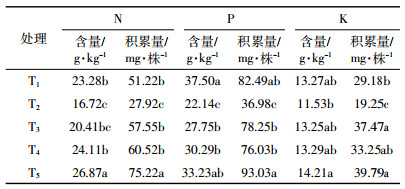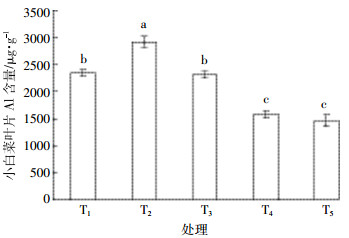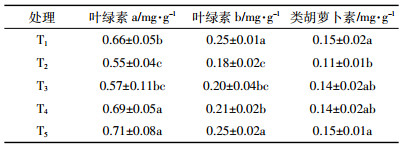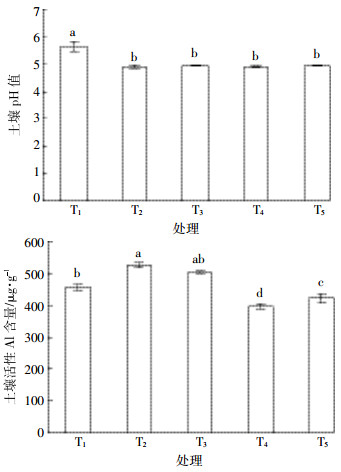文章信息
- 吕波, 王宇函, 姜存仓
- LÜ Bo, WANG Yu-han, JIANG Cun-cang
- 脯氨酸缓解酸性土壤上小白菜铝毒胁迫的效应及其潜在机制
- Effects of proline application and their potential mechanisms on pakchoi under aluminum stress in acidic soil
- 农业环境科学学报, 2018, 37(5): 868-874
- Journal of Agro-Environment Science, 2018, 37(5): 868-874
- http://dx.doi.org/10.11654/jaes.2017-1103
文章历史
- 收稿日期: 2017-08-14
- 录用日期: 2017-11-28
我国以酸性土壤为主,铝(Al)毒是限制作物生长和减少产量的重要原因之一[1]。通常情况下,土壤中Al以难溶性或固定状态存在于土壤固相中,对植物不产生毒害作用,当土壤pH < 5时,活性铝含量就随pH值降低而升高[2],它们存在于土壤介质中,直接对植物产生胁迫作用。植物在Al胁迫下,其根尖结构遭破坏,根系伸长被抑制,根系活力降低[3],Al胁迫阻碍植物对养分的吸收,降低其抵抗外界环境变化的能力,从而影响植物生长和作物产量[4]。脯氨酸(Pro)在植物体内水溶性较强,可以被植物快速吸收[5],是植物体内最有效的渗透调节物质之一。有关研究表明,Pro可以提高油菜、水稻等作物产量[6]、抵御逆境胁迫过程[7]以及提高植物叶绿素的含量[8];Pro还可促进植物对必需元素(如钙、镁等)的利用[9],改善光合作用过程[10],并提高代谢能力。植物在逆境条件下易产生活性氧,Pro可与活性氧结合,使植物免受伤害[11]。Pro还可作为重金属、低温、高温等逆境胁迫条件下植物的保护剂,提高植物抗氧化酶活性,增强植物抗逆性[12]。在逆境胁迫条件下可通过施用外源Pro来提高植物抗逆能力[13]。目前关于外源Pro缓解盐以及重金属等胁迫的研究很多[14-15],但是对于外源Pro缓解Al胁迫的研究却鲜有报道。因此,本文研究了不同浓度外源Pro对Al胁迫下小白菜产量、生理特性的影响,为外源Pro对Al毒缓解的应用提供科学的理论依据。
1 材料与方法 1.1 试验材料本试验于2017年3—5月在华中农业大学盆栽场进行,供试作物为小白菜“四月慢”。供试土壤为黄棕壤,取自校内大田耕层。土壤经自然风干后,除去石块及植物未腐烂残体后研磨过2 mm筛,混匀后备用。其基本理化性质:pH值5.2,有机质13.3 g·kg-1,全氮0.81 g·kg-1,碱解氮38.9 mg·kg-1,速效磷49.2 mg·kg-1,速效钾169.4 mg·kg-1,活性Al 407.5 μg·g-1。
1.2 试验设计本试验以土培盆栽的方式进行,设置T1(0外源Al+0外源Pro)、T2(外源Al)、T3(外源Al+10 mmol·L-1外源Pro)、T4(外源Al+20 mmol·L-1外源Pro)、T5(外源Al+50 mmol·L-1外源Pro)5个处理,每个处理4次重复。外源Al为AlCl3·6H2O(分子量为241.43),微量元素用Arnon营养液配方(pH值为6.0)。取过2 mm筛的风干土样1.5 kg于盆中,称取底肥:NH4NO3 0.571 g·kg-1,KH2PO4 0.439 g·kg-1,KCl 0.141 g·kg-1,AlCl3·6H2O 0.242 g·kg-1。外源Al和基肥按试验处理分别施入土壤且均匀混合。种子晾晒后浸泡于纯水中过夜(4 ℃),挑选饱满一致的种子于塑料盆中,每盆播种约20颗,分散距离均匀,在温室内培养至发芽,发芽后间苗培养,用不同浓度外源Pro溶液进行灌根处理,于2月28日播种,3月14日第一次处理,每7 d进行1次,每次用量50 mL,总共3次,T3、T4和T5外源Pro总施用量分别为每盆0.17、0.34 g和0.86 g,4月14日收获,期间每日浇水,运用重量差减法使水分维持约75%田间持水量,共培养45 d。
1.3 指标测定与方法 1.3.1 样品采集收获时,调查小白菜株高等农艺性状,称取每盆产量(地上部可食部分鲜重),每盆随机取1株样品测定叶绿素、抗氧化酶以及丙二醛(MDA)等鲜样指标,所有样品在105 ℃下杀青30 min,60 ℃烘干称干重,把干样磨碎后供分析测试用。样品收获后,将不同处理的土样风干磨细并分别过20目和100目的筛子,土样用自封袋保存供分析测试用。
1.3.2 植物样品测定采用乙醇比色法[16]测定植物叶片叶绿素含量;采用愈创木酚法[16]测定过氧化物酶(POD)活性;采用NBT还原法[16]测定超氧化物歧化酶(SOD)活性;采用紫外分光光度法[16]测定过氧化氢酶(CAT)活性;采用硫代巴比妥反应法[16]测定MDA含量;采用浓H2SO4-H2O2消煮,蒸馏定氮法测定植株氮含量[17],钼锑抗比色法测定植株磷含量[17]、火焰光度法测定植株钾含量[17]。采用硝酸和高氯酸混酸消解-石墨炉原子吸收分光光度法[18]测定植物叶片Al含量。
1.3.3 土壤基本理化性质测定土壤样品用于测定收获后土壤的基本理化性质以及土壤的活性Al含量。土壤基本理化性质参照鲍士旦[17]编制的《土壤农化分析》测定:使用pH计测定土壤pH值(土水比1:2.5),10.0 g土+25.0 mL水;碱解扩散法测定土壤碱解氮;NH4OAc浸提,火焰光度法测定土壤速效钾;0.5 mol·L-1 NaHCO3浸提,钼锑抗比色法测定土壤有效磷;用庞叔薇等[19]提出的浸提方法测定土壤活性Al的含量。
1.4 数据处理与分析试验公式[20]:
养分积累量=养分含量×植株干物质积累量。
采用Excel 2010对数据进行处理分析和作图。用SAS进行单因素方差分析,t检验差异显著性水平为0.05。
2 结果与分析 2.1 外源Pro对Al胁迫下小白菜产量的影响从表 1可知,相对于T1,单施Al使小白菜产量、干重和株高显著降低,株高和产量分别减少了9.2%和10.6%,均达到显著水平;Al胁迫下,不同浓度外源Pro使小白菜株高、产量和干重显著增大,株高分别提高了17.8%、25.4%和14.4%,产量分别升高了28.4%、38.4%和65.2%。Al胁迫下,不同浓度外源Pro处理的产量相对于T1均增加,且有逐渐升高的趋势,其中50 mmol·L-1外源Pro处理产量最高,提高了约37.1%。因此说明外源Pro具有缓解Al对小白菜生长胁迫和提高小白菜产量的作用。

|
从表 2得出,相对于T1,Al胁迫下小白菜的氮、磷、钾含量明显降低,分别减少了28.2%、40.9%和13.1%,养分总积累量分别降低了45.5%、55.2%和34.0%,均达到显著水平,Al对小白菜养分吸收产生抑制作用。Al胁迫下施加不同浓度外源Pro,小白菜的氮、磷、钾含量均明显上升,且随着Pro浓度的升高,养分含量呈现逐渐升高的趋势,浓度为50 mmol·L-1时养分含量最高,相对于T2氮、磷、钾含量分别增加了60.7%、50.0%和23.2%;此外,小白菜养分总积累量明显增加,缓解Al对小白菜的抑制作用,其中50 mmol·L-1缓解效果最好,相对于T2氮、磷、钾总积累量分别增加了169.4%、151.6%和106.6%。因此,外源Pro可缓解Al对小白菜养分吸收的抑制,促进小白菜对养分的积累。

|
从图 1得出,Al胁迫下小白菜叶片Al含量相对于T1显著提高了24.3%,施加外源Pro后,小白菜叶片Al含量显著降低,分别降低了20.4%、45.6%和49.8%,说明外源Pro可减少小白菜对Al的吸收,缓解Al胁迫作用。随着外源Pro浓度升高,小白菜叶片Al含量呈现逐渐降低的趋势,且均低于T1水平,其中50 mmol·L-1外源Pro缓解效果较好。

|
| 图 1 外源Pro对Al胁迫下小白菜叶片Al含量的影响 Figure 1 Exogenous proline effect on the content of aluminum in pakchoi leaves under aluminum stress |
如表 3所示,Al会减少叶绿素含量,破坏小白菜叶片的叶绿素。相对于T1,T2处理的小白菜叶片叶绿素受到破坏,叶绿素a含量减少17.3%,叶绿素b减少27.2%,类胡萝卜素含量减少29.0%,且均达到显著水平;Al胁迫下施加不同浓度外源Pro后,T3、T4、T5处理叶绿素含量均相应地增加,随着外源Pro浓度升高,叶绿素含量呈现递增趋势,其中50 mmol·L-1外源Pro的缓解效果较好,叶绿素a、b和类胡萝卜素含量分别提高了29.1%、38.9%和36.4%。外源Pro对Al胁迫下小白菜叶片叶绿素含量产生了一定的影响,但并未显著提高,只是缓解并逐渐恢复到T1水平。

|
从表 4得知,相对于T1,添加外源Al,POD、SOD和CAT活性分别降低了13.7%、21.1%和30.4%,MDA含量显著升高了58.8%;Al胁迫下,不同浓度外源Pro使抗氧化酶活性显著提高,MDA含量显著降低,其中50 mmol·L-1效果最好,POD活性提高了24.3%,SOD活性升高了266.9%,CAT活性提高了142.6%,MDA含量降低了40.8%。随着外源Pro浓度升高,POD、SOD和CAT活性呈现逐渐升高的趋势,最终均比T1水平高,说明外源Pro可减弱Al对抗氧化酶活性的影响。因此,外源Pro可增强抗氧化酶活性来缓解Al胁迫。

|
从图 2可得出,相对于T1,外源Al使土壤pH值由5.65减少为4.90,降低了0.75个单位,达到显著水平,施加不同浓度外源Pro后,土壤pH值并未明显改善,未达到显著水平,说明外源Pro对Al胁迫下土壤pH值的影响不大。T1土壤活性Al含量为456.02 μg·g-1,T2土壤活性Al含量为525.86 μg·g-1,本试验外源Al施加量为27 μg·g-1,增加量为69.84 μg·g-1,增加量大于施加量;施加外源Pro后,土壤活性Al含量分别降低了4.3%、24.5%和19.7%。外源Al使土壤pH值降低,活性Al含量升高,说明土壤pH值降低对活性Al含量升高有一定的影响;添加外源Pro后,土壤pH值未明显变化,但土壤活性Al含量显著降低,说明外源Pro对Al胁迫下土壤活性Al含量的影响并不是通过调节土壤pH值实现的。

|
| 图 2 源Pro对Al胁迫下土壤pH值和活性Al含量的影响 Figure 2 Exogenous proline effect on soil pH and available Al content under aluminum stress |
植物在生长过程中需要适宜的土壤环境,但实际上土壤环境中存在着很多限制作物生长的因素,如土壤pH值降低、活性Al含量过多导致的Al毒[4]等。Al毒对植物生长发育的影响主要表现为根系吸收养分受到阻碍、生长受到抑制、产量降低等[21]。本试验发现,在黄棕壤中施加外源Al后,土壤pH值下降了0.75个单位,小白菜的氮、磷、钾含量分别减少了28.2%、40.9%和13.1%,养分总积累量分别降低了45.5%、55.2%和34.0%,小白菜株高降低了9.2%,产量减少了10.6%,说明土壤pH值降低是Al胁迫下小白菜产量下降和生长发育受限制的重要原因之一。
有研究[22]表明,逆境胁迫下,植物易产生活性氧,直接对植物的生理特性产生影响。植物体内与活性氧消除有关的酶活性在逆境胁迫下一般会增强,从而植物抗氧化能力得到提高。Okuma等[23]发现10 mmol·L-1 Pro促进悬浮培养烟草细胞的生长;Hoque等[24]发现Pro可提高植物叶片抗氧化酶活性。本研究发现,外源Al使POD、SOD和CAT的活性显著降低,分别降低了13.7%、21.1%和30.4%,使膜脂过氧化产物MDA含量显著升高,升高了58.8%,对小白菜的抗氧化酶系统造成损害,施加不同浓度外源Pro后,促进小白菜SOD、POD和CAT活性,减少MDA在体内的积累,从而减轻膜脂过氧化程度和增强抗氧化能力。外源Pro缓解Al胁迫的原因可能在于作为活性氧消除剂,激发体内POD、SOD以及CAT的活性,降低活性氧对植物的危害,增强小白菜抵抗逆境的能力,Anjum等[25]研究也证实了这一点。除此之外,Ashraf等[26]研究认为外源Pro缓解逆境胁迫效果取决于作物的类型以及Pro的浓度等,适宜Pro浓度可能在5~60 mmol·L-1之间[27-28]。本试验设置3个浓度,综合数据发现在提高产量、抗氧化酶活性、叶绿素含量和养分总积累量以及降低MDA含量、植物叶片Al含量和土壤活性Al含量等方面,浓度为50 mmol·L-1时缓解效果较好,此浓度在研究范围之内。
3.2 外源Pro及外源Al对小白菜和土壤Al含量的影响本试验中,外源Al的施入使得土壤活性Al含量增加,土壤活性Al含量从456.02 μg·g-1增加到了525.86 μg·g-1,增加量为69.84 μg·g-1,大于施加量27 μg·g-1,说明外源Al可使土壤固定态Al转化成活性Al,这与应介官等[29]研究生物炭及外源Al对土壤Al含量试验结果相似。除此之外,施加不同浓度外源Pro后,小白菜和土壤中的Al含量加上外源Al的施入量,T2~T5 4个处理Al总量呈现下降的趋势。有研究[30-31]表明,土壤活性Al含量与土壤pH值有密切关系,当土壤pH < 5时,土壤活性Al含量随pH值降低而升高,但在本实验中,外源Pro并没有显著提高土壤pH值,因此降低土壤和植物中Al含量并不是通过提高土壤pH值来实现的,对此Bolan等[32]研究发现有机酸可以与活性Al形成对植物无害的稳定物质,宋敏等[21]的研究也证实外源Pro可与自由金属离子形成无毒的金属-Pro复合物,减轻金属对植物抗氧化酶活性以及光合中心离子的毒害作用。因此本试验主要原因可能在于外源Pro与土壤活性Al相结合使土壤活性Al转化成Al-Pro稳定复合物,外源Pro被植物吸入体内直接转化成内源Pro与体内Al形成某种稳定物质[21],且这两种物质对植物没有危害,从而同时降低了土壤和小白菜中Al含量,这也解释了总体下降趋势的问题。
3.3 外源Pro的应用前景Pro是一种可溶性的渗透调节物质,中性条件下不带电,具有分子量低、水溶性高等特点[33-34]。Pro性质稳定,可在常温和常压条件下稳定存在。Pro对植物具有两方面积极作用,充当逆境调节物质和能量[35-36]:植物在逆境胁迫条件下,Pro可以与胁迫条件产生的氧自由基发生反应转变为无害物质,消除活性氧危害;当植物从胁迫条件恢复正常时,Pro降解产生能量,可作为氮、磷的快速补偿能源。目前关于Pro的研究很多,主要倾向于其在植物体内的抗逆机制[37],多应用于缓解干旱、高温、盐胁迫和重金属等[38]逆境胁迫,但是目前有关Pro功能和植物抗逆性的研究都是在培养室中进行的,在野外条件下还没得到成功的验证[13]。Pro由于其高水溶性可作为水溶肥施用,成本较低,为新型肥料研究提供新的思路。
4 结论(1)外源Al使土壤pH值降低,土壤活性Al含量增加,植物体内Al含量升高,抗氧化酶活性减弱,膜脂过氧化程度增强,叶绿素破坏,养分总积累量减少,Al对小白菜生长产生胁迫作用。
(2)Al胁迫下施用不同浓度外源Pro未明显提高土壤pH值,可使土壤活性Al含量下降,植物体内Al含量下降,抗氧化酶活性提高,膜脂过氧化程度减弱,叶绿素恢复到正常水平,养分总积累量增加。外源Pro有效地缓解了Al对小白菜生长的抑制,且50 mmol·L-1外源Pro对Al胁迫缓解效果较好。
| [1] |
陈荣府, 沈仁芳. 水稻(Oryza sativa L.)铝毒害与耐性机制及铝毒害的缓解作用[J]. 土壤, 2004, 36(5): 481-491. CHEN Rong-fu, SHEN Ren-fang. Mechanisms of aluminum toxicity and tolerance of rice(Oryza Sativa L.) and catabolism of Al stress in acid soils[J]. Soils, 2004, 36(5): 481-491. |
| [2] |
刘鹏, YangY S, 徐根娣, 等. 南方4种草本植物对铝胁迫生理响应的研究[J]. 植物生态学报, 2005, 29(4): 644-651. LIU Peng, Yang Y S, XU Gen-di, et al. Physiological response of four sourthern herbaceous plants to aluminum stress[J]. Acta Phytoecologica Sinica, 2005, 29(4): 644-651. DOI:10.17521/cjpe.2005.0086 |
| [3] |
吴道铭, 傅友强, 于智卫, 等. 我国南方红壤酸化和铝毒现状及防治[J]. 土壤, 2013, 45(4): 577-584. WU Dao-ming, FU You-qiang, YU Zhi-wei, et al. Status of red soil acidification and aluminum toxicity in South China and prevention[J]. Soils, 2013, 45(4): 577-584. |
| [4] |
Kochian L V, Hoekenga O A, Piñeros M A. How do crop plants tolerate acid soils? Mechanisms of aluminum tolerance and phosphorous efficiency[J]. Annual Review of Plant Biology, 2004, 55(1): 459-493. DOI:10.1146/annurev.arplant.55.031903.141655 |
| [5] |
Shah K, Kumar R G, Verma S, et al. Effect of cadmium on lipid peroxidation, superoxide anion generation and activities of antioxidant enzymes in growing rice seedlings[J]. Plant Science, 2001, 161(6): 1135-1144. DOI:10.1016/S0168-9452(01)00517-9 |
| [6] |
Habbasha E. Amelioration of the growth, yield and chemical constituents of canola plants grown under salinity stress condition by exogenous application of proline[J]. 2014, 2(11): 501-508.
|
| [7] |
沙汉景, 刘化龙, 王敬国, 等. 外源脯氨酸对盐胁迫下水稻分蘖期生长的影响[J]. 农业现代化研究, 2013, 34(2): 230-234. SHA Han-jing, LIU Hua-long, WANG Jing-guo, et al. Effects of exogenous proline on growth of rice at tillering stage under salt stress[J]. Research of Agricultural Modernization, 2013, 34(2): 230-234. |
| [8] |
唐依萍, 张晓艳, 刘士壮, 等. 外源脯氨酸对NaCl胁迫下番茄幼苗光合特性的影响[J]. 安徽农业科学, 2015, 43(24): 9-11. TANG Yi-ping, ZHANG Xiao-yan, LIU Shi-zhuang, et al. Effects of exogenous proline on photosynthetic characteristics of tomato seedlings under NaCl stress[J]. Anhui Agricultural Sciences, 2015, 43(24): 9-11. DOI:10.3969/j.issn.0517-6611.2015.24.004 |
| [9] |
Szabados L, Savouré A. Proline:A multifunctional amino acid[J]. Trends in Plant Science, 2010, 15(2): 89-97. DOI:10.1016/j.tplants.2009.11.009 |
| [10] |
颜志明, 孙锦, 郭世荣. 外源脯氨酸对盐胁迫下甜瓜幼苗生长、光合作用和光合荧光参数的影响[J]. 江苏农业学报, 2013, 29(5): 1125-1130. YAN Zhi-ming, SUN Jin, GUO Shi-rong. Effects of exogenous proline on seedling growth, photosynthesis and photosynthetic fluorescence characteristics in leaves of melon under salt stress[J]. Jiangsu Journal of Agricultural Sciences, 2013, 29(5): 1125-1130. |
| [11] |
Dai Q L, Chen C, Feng B, et al. Effects of different NaCl concentration on the antioxidant enzymes in oilseed rape(Brassica napus L.) seedlings[J]. Plant Growth Regulation, 2009, 59(3): 273-278. DOI:10.1007/s10725-009-9402-z |
| [12] |
黄运湘, 王志坤, 袁红, 等. 大豆对镉胁迫的生理反应及耐镉机理探讨[J]. 农业环境科学学报, 2011, 30(8): 1514-1520. HUANG Yun-xiang, WANG Zhi-kun, YUAN Hong, et al. Physiological responses of soybean(Glycine max) to cadmium stress and its tolerance mechanism[J]. Journal of Agro-Environment Science, 2011, 30(8): 1514-1520. |
| [13] |
Mmf M, Ali E F. Evaluation of proline functions in saline conditions[J]. Phytochemistry, 2017, 140: 52-68. DOI:10.1016/j.phytochem.2017.04.016 |
| [14] |
张金凤, 孙明高, 夏阳, 等. 盐胁迫对石榴和樱桃脯氨酸含量和硝酸还原酶活性及电导率的影响[J]. 山东农业大学学报(自然科学版), 2004, 35(2): 164-168. ZHANG Jin-feng, SUN Ming-gao, XIA Yang, et al. Salt stresses affect proline contents, nitrate reductase activities and electrical conductivity of seedling leaves of megranate and cherry[J]. Journal of Shandong Agricultural University(Natural Science), 2004, 35(2): 164-168. |
| [15] |
段九菊, 郭世荣, 樊怀福, 等. 盐胁迫对黄瓜幼苗根系脯氨酸和多胺代谢的影响[J]. 西北植物学报, 2006, 26(12): 2486-2492. DUAN Jiu-ju, GUO Shi-rong, FAN Huai-fu, et al. Effects of salt stress on proline and polyamine metabolisms in the roots of cucumber seedlings[J]. Acta Botanica Boreali-Occidentalia Sinica, 2006, 26(12): 2486-2492. DOI:10.3321/j.issn:1000-4025.2006.12.014 |
| [16] |
王学奎. 植物生理生化实验原理和技术[M]. . WANG Xue-kui. Principles and techniques of plant physiological biochemical experiment[M]. . |
| [17] |
鲍士旦. 土壤农化分析[M]. . BAO Shi-dan. Soil and agricultural chemistry analysis[M]. . |
| [18] |
Ramsey M H, Dong D, Thornton I, et al. Discrimination between aluminium held within vegetation and that contributed by soil contamination using a combination of Electron Probe Micro Analysis(EPMA) and Inductively Coupled Plasma-Atomic Emission Spectrometry(ICP-AES)[J]. Environmental Geochemistry & Health, 1991, 13(2): 114-118. |
| [19] |
庞叔薇, 康德梦, 王玉保, 等. 化学浸提法研究土壤中活性铝的溶出及形态分布[J]. 环境化学, 1986, 5(3): 70-78. PANG Shu-wei, KANG De-meng, WANG Yu-bao, et al. Studies on the leaching of active aluminum from soil and the distribution of aluminum species by chemical extraction[J]. Environmental Chemistry, 1986, 5(3): 70-78. |
| [20] |
王永华, 黄源, 辛明华, 等. 周年氮磷钾配施模式对砂姜黑土麦玉轮作体系籽粒产量和养分利用效率的影响[J]. 中国农业科学, 2017, 50(6): 1031-1046. WANG Yong-hua, HUANG Yuan, XIN Ming-hua, et al. Effects of the year-round management model of N, P and K combined application on grain yield and nutrient efficiency of wheat-maize rotation system in lime concretion black soil[J]. Scientia Agricultura Sinica, 2017, 50(6): 1031-1046. DOI:10.3864/j.issn.0578-1752.2017.06.005 |
| [21] |
宋敏, 徐文竞, 彭向永, 等. 外源脯氨酸对镉胁迫下小麦幼苗生长的影响[J]. 应用生态学报, 2013, 24(1): 129-134. SONG Min, XU Wen-jing, PENG Xiang-yong, et al. Effects of exogenous proline on the growth of wheat seedlings under cadmium stress[J]. Chinese Journal of Applied Ecology, 2013, 24(1): 129-134. |
| [22] |
陶爱芬, 陈娴娴, 祁建民, 等. 外源硒及脯氨酸对菜用黄麻生长和生理特性的影响[J]. 中国麻业科学, 2015, 37(5): 239-245. TAO Ai-fen, CHEN Xian-xian, QI Jian-min, et al. Effects of exogenous selenium and proline on growth and physiological characteristics of edible jute[J]. Plant Fiber Sciences in China, 2015, 37(5): 239-245. |
| [23] |
Okuma E, Soeda K, Tada M, et al. Exogenous proline mitigates the inhibition of growth of Nicotiana tabacum cultured cells under saline conditions[J]. Soil Science & Plant Nutrition, 2000, 46(1): 257-263. |
| [24] |
Hoque M A, Banu M N, Okuma E, et al. Exogenous proline and glycinebetaine increase NaCl-induced ascorbate-glutathione cycle enzyme activities, and proline improves salt tolerance more than glycinebetaine in tobacco Bright Yellow-2 suspension-cultured cells[J]. Journal of Plant Physiology, 2007, 164(11): 1457-68. DOI:10.1016/j.jplph.2006.10.004 |
| [25] |
Anjum F, Rishi V, Ahmad F. Compatibility of osmolytes with Gibbs energy of stabilization of proteins[J]. Biochimica et Biophysica Acta, 2000, 1476(1): 75-84. DOI:10.1016/S0167-4838(99)00215-0 |
| [26] |
Ashraf M, Foolad M R. Roles of glycine betaine and proline in improving plant abiotic stress resistance[J]. Environmental & Experimental Botany, 2007, 59(2): 206-216. |
| [27] |
Roy D, Basu N, Bhunia A, et al. Counteraction of exogenous L-proline with NaCl in salt-sensitive cultivar of rice[J]. Biologia Plantarum, 1993, 35(1): 69-72. DOI:10.1007/BF02921122 |
| [28] |
Yamada M, Morishita H, Urano K, et al. Effects of free proline accumulation in petunias under drought stress[J]. Journal of Experimental Botany, 2005, 56(417): 1975-1981. DOI:10.1093/jxb/eri195 |
| [29] |
应介官, 林庆毅, 张梦阳, 等. 生物炭对铝富集酸性土壤的毒性缓解效应及潜在机制[J]. 中国农业科学, 2016, 49(23): 4576-4583. YING Jie-guan, LIN Qing-yi, ZHANG Meng-yang, et al. Mitigative effect of biochar on aluminum toxicity of acid soil and the potential mechanism[J]. Scientia Agricultura Sinica, 2016, 49(23): 4576-4583. DOI:10.3864/j.issn.0578-1752.2016.23.010 |
| [30] |
王维君, 陈家坊. 土壤铝形态及其溶液化学的研究[J]. 土壤学进展, 1992, 20(3): 10-18. WANG Wei-jun, CHEN Jia-fang. The study of soil aluminum form and its solution chemistry[J]. Progress in Soil Science, 1992, 20(3): 10-18. |
| [31] |
吕焕哲, 王凯荣, 谢小立. 土地利用方式与坡位土壤活性铝形态特征分析[J]. 水土保持学报, 2007, 21(1): 172-175. LÜ Huan-zhe, WANG Kai-rong, XIE Xiao-li. Character of soil aluminum forms under different land use and slope position[J]. Journal of Soil & Water Conservation, 2007, 21(1): 172-175. |
| [32] |
Bolan D N S, Naidu R, Mahimairaja S, et al. Influence of low-molecular-weight organic acids on the solubilization of phosphates[J]. Biology & Fertility of Soils, 1994, 18(4): 311-319. |
| [33] |
Maggio A, Miyazaki S, Veronese P, et al. Does proline accumulation play an active role in stress-induced growth reduction[J]. Plant Journal, 2002, 31(6): 699-712. DOI:10.1046/j.1365-313X.2002.01389.x |
| [34] |
Jiao R, Liu H B, Liu G S, et al. Discussion of accumulation of proline and its relationship with osmotic stress tolerance of plants[J]. Chinese Agricultural Science Bulletin, 2011, 71(10): 7704-7710. |
| [35] |
Floyd R A, Nagy I. Formation of long-lived hydroxyl free radical adducts of proline and hydroxyproline in a fenton reaction[J]. Biochimica et Biophysica Acta, 1984, 790(1): 94-97. DOI:10.1016/0167-4838(84)90337-6 |
| [36] |
Ahmad I, Hellebust J A. The Relationship between inorganic nitrogen metabolism and proline accumulation in osmoregulatory responses of two euryhaline microalgae[J]. Plant Physiology, 1988, 88(2): 348-354. DOI:10.1104/pp.88.2.348 |
| [37] |
Daly S, Yacoub A, Dundon W, et al. Isolation and characterization of a gene encoding alpha-tubulin from Candida albicans[J]. Gene, 1997, 187(2): 151-158. DOI:10.1016/S0378-1119(96)00737-8 |
| [38] |
Quan X Q, Zhang Y J, Shan L. The Roles of proline in plant growth and the tolerance to abiotic stresses[J]. Letters in Biotechnology, 2007(1): 159-162. |
 2018, Vol. 37
2018, Vol. 37




